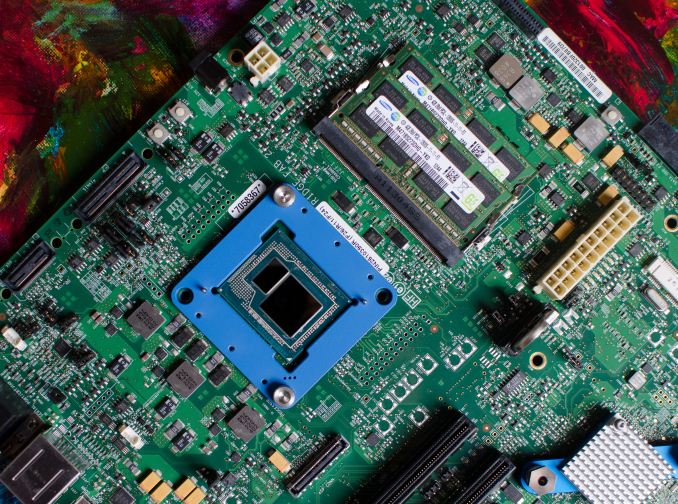Intel Iris Pro 5200 Graphics Review: Core i7-4950HQ Tested
by Anand Lal Shimpi on June 1, 2013 10:01 AM ESTFinal Words
For the past few years Intel has been threatening to make discrete GPUs obsolete with its march towards higher performing integrated GPUs. Given what we know about Iris Pro today, I'd say NVIDIA is fairly safe. The highest performing implementation of NVIDIA's GeForce GT 650M remains appreciably quicker than Iris Pro 5200 on average. Intel does catch up in some areas, but that's by no means the norm. NVIDIA's recently announced GT 750M should increase the margin a bit as well. Haswell doesn't pose any imminent threat to NVIDIA's position in traditional gaming notebooks. OpenCL performance is excellent, which is surprising given how little public attention Intel has given to the standard from a GPU perspective.
Where Iris Pro is dangerous is when you take into account form factor and power consumption. The GT 650M is a 45W TDP part, pair that with a 35 - 47W CPU and an OEM either has to accept throttling or design a cooling system that can deal with both. Iris Pro on the other hand has its TDP shared by the rest of the 47W Haswell part. From speaking with OEMs, Iris Pro seems to offer substantial power savings in light usage (read: non-gaming) scenarios. In our 15-inch MacBook Pro with Retina Display review we found that simply having the discrete GPU enabled could reduce web browsing battery life by ~25%. Presumably that delta would disappear with the use of Iris Pro instead.
Lower thermal requirements can also enabler smaller cooling solutions, leading to lighter notebooks. While Iris Pro isn't the fastest GPU on the block, it is significantly faster than any other integrated solution and does get within striking distance of the GT 650M in many cases. Combine that with the fact that you get all of this in a thermal package that a mainstream discrete GPU can't fit into and this all of the sudden becomes a more difficult decision for an OEM to make.
Without a doubt, gaming focused notebooks will have to stick with discrete GPUs - but what about notebooks like the 15-inch MacBook Pro with Retina Display? I have a dedicated PC for gaming, I use the rMBP for work and just need a GPU that's good enough to drive everything else in OS X. Intel's HD 4000 comes close, and I suspect Iris Pro will completely negate the need for a discrete GPU for non-gaming use in OS X. Iris Pro should also be competent enough to make modern gaming possible on the platform as well. Just because it's not as fast as a discrete GPU doesn't mean that it's not a very good integrated graphics solution. And all of this should come at a much lower power/thermal profile compared to the current IVB + GT 650M combination.
Intel clearly has some architectural (and perhaps driver) work to do with its Gen7 graphics. It needs more texture hardware per sub-slice to remain competitive with NVIDIA. It's also possible that greater pixel throughput would be useful as well but that's a bit more difficult to say at this point. I would also like to see an increase in bandwidth to Crystalwell. While the 50GB/s bi-directional link is clearly enough in many situations, that's not always the case.
Intel did the right thing with making Crystalwell an L4 cache. This is absolutely the right direction for mobile SoCs going forward and I expect Intel will try something similar with its low power smartphone and tablet silicon in the next 18 - 24 months. I'm pleased with the size of the cache and the fact that it caches both CPU and GPU memory. I'm also beyond impressed that Intel committed significant die area to both GPU and eDRAM in its Iris Pro enabled Haswell silicon. The solution isn't perfect, but it is completely unlike Intel to put this much effort towards improving graphics performance - and in my opinion, that's something that should be rewarded. So I'm going to do something I've never actually done before and give Intel an AnandTech Editors' Choice Award for Haswell with Iris Pro 5200 graphics.
This is exactly the type of approach to solving problems I expect from a company that owns around a dozen modern microprocessor fabs. Iris Pro is the perfect example of what Intel should be doing across all of the areas it competes in. Throw smart architecture and silicon at the problem and don't come back whining to me about die area and margins. It may not be the fastest GPU on the block, but it's definitely the right thing to do.
I'm giving Intel our lowest award under the new system because the solution needs to be better. Ideally I wouldn't want a regression from GT 650M performance, but in a pinch for a mostly work notebook I'd take lower platform power/better battery life as a trade in a heartbeat. This is absolutely a direction that I want to see Intel continue to explore with future generations too. I also feel very strongly that we should have at least one (maybe two) socketed K-series SKUs with Crystalwell on-board for desktop users. It is beyond unacceptable for Intel to not give its most performance hungry users the fastest Haswell configuration possible. Most companies tend to lose focus of their core audience as they pursue new markets and this is a clear example of Intel doing just that. Desktop users should at least have the option of buying a part with Crystalwell on-board.
So much of Intel's march towards improving graphics has been driven by Apple, I worry about what might happen to Intel's motivation should Apple no longer take such an aggressive position in the market. My hope is that Intel has finally realized the value of GPU performance and will continue to motivate itself.












177 Comments
View All Comments
Death666Angel - Tuesday, June 4, 2013 - link
"What Intel hopes however is that the power savings by going to a single 47W part will win over OEMs in the long run, after all, we are talking about notebooks here."This plus simpler board designs and fewer voltage regulators and less space used.
And I agree, I want this in a K-SKU.
Death666Angel - Tuesday, June 4, 2013 - link
And doesn't MacOS support Optimus?RE: "In our 15-inch MacBook Pro with Retina Display review we found that simply having the discrete GPU enabled could reduce web browsing battery life by ~25%."
GullLars - Tuesday, June 4, 2013 - link
Those are strong words in the end, but i agree Intel should make a K-series CPU with Crystalwell. What comes to mind is they may be doing that for Broadwell.The Iris Pro solution with eDRAM looks like a nice fit for what i want in my notebook upgrade coming this fall. I've been getting by on a Core2Duo laptop, and didn't go for Ivy Bridge because there were no good models with a 1920x1200 or 1920x1080 display without dedicated graphics. For a system that will not be used for gaming at all, but needs resolution for productivity, it wasn't worth it. I hope this will change with Haswell, and that i will be able to get a 15" laptop with >= 1200p without dedicated graphics. 4950HQ or 4850HQ seems like an ideal fit. I don't mind spending $1500-2000 for a high quality laptop :)
IntelUser2000 - Tuesday, June 4, 2013 - link
ANAND!!You got the FLOPs rating wrong on the Sandy Bridge parts. They are at 1/2 of Ivy Bridge.
1350MHz with 12 EUs and 8 FLOPs/EU will result in 129.6GFlops. While its true in very limited scenarios Sandy Bridge's iGPU can co-issue, its small enough to be non-existent. That is why a 6EU HD 2500 comes close to 12EU HD 3000.
Hrel - Tuesday, June 4, 2013 - link
If they use only the HD4600 and Iris Pro that'd probably be better. As long as it's clearly labeled on laptops. HD 4600 Pro (don't expect to do any video work on this) Iris Pro (it's passable in a pinch).But I don't think that's what's going to happen. Iris Pro could be great for Ultrabooks; I don't really see any use outside of that though. A low end GT740M is still a better option in any laptop that has the thermal room for it. Considering you can put those in 14" or larger ultrabooks I still think Intel's graphics aren't serious. Then you consider the lack of Compute, PhysX, Driver optimization, game specific tuning...
Good to see a hefty performance improvement. Still not good enough though. Also pretty upsetting to see how many graphics SKU's they've released. OEM'S are gonna screw people who don't know just to get the price down.
Hrel - Tuesday, June 4, 2013 - link
The SKU price is 500 DOLLARS!!!! They're charging you 200 bucks for a pretty shitty GPU. Intel's greed is so disgusting it over rides the engineering prowess of their employees. Truly disgusting Intel; to charge that much for that level of performance. AMD we need you!!!!xdesire - Tuesday, June 4, 2013 - link
May i ask a noob question? Question: Do we have no i5s, i7s WITHOUT on board graphics any more? As a gamer i'd prefer to have a CPU + discrete GPU in my gaming machine and i don't like to have extra stuff stuck on the CPU, lying there consuming power and having no use (for my part) whatsoever. No ivy bridge or haswell i5s, i7s without iGPU or whatever you call it?flyingpants1 - Friday, June 7, 2013 - link
They don't consume power while they're not in use.Hrel - Tuesday, June 4, 2013 - link
WHY THE HELL ARE THOSE SO EXPENSIVE!!!!! Holy SHIT! 500 dollars for a 4850HQ? They're charging you 200 dollars for a shitty GPU with no dedicated RAM at all! Just a cache! WTFF!!!Intel's greed is truly disgusting... even in the face of their engineering prowess.
MartenKL - Wednesday, June 5, 2013 - link
What I don't understand is why Intel didn't do a "next-gen console like processor". Like takeing the 4770R and doubling the GPU or een quadrupling, wasn't there space? The thermal headroom must have been there as we are used to CPUs with as high as 130W TDP. Anyhow, combining that with awesome drivers for Linux would have been a real competition to AMD/PS4/XONE for Valve/Steam. A complete system under 150w capable of awesome 1080p60 gaming.So now I am looking for the best performing GPU under 75W, ie no external power. Which is it, still the Radeon HD7750?